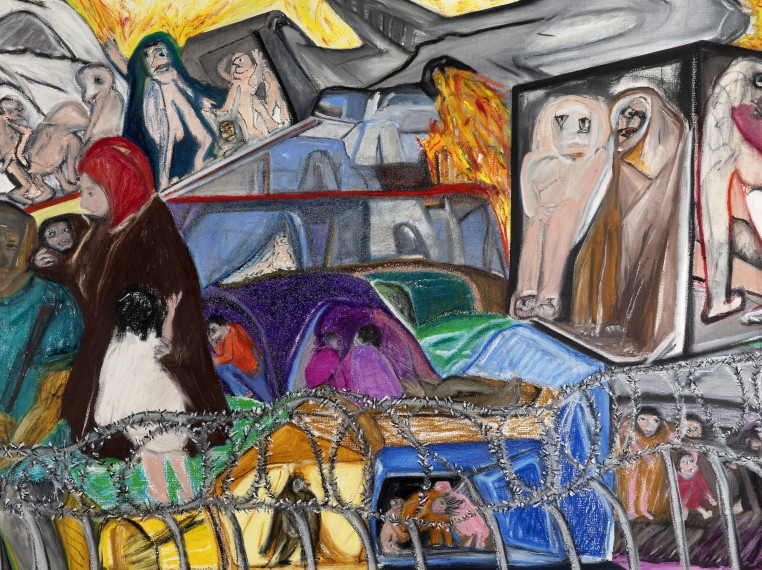
Installation View, Ortuzar, Frize Masters 2024. Photo: Todd-White Art Photography.
Installation View, Ortuzar, Frize Masters 2024. Photo: Todd-White Art Photography.
Installation View, Ortuzar, Frize Masters 2024. Photo: Todd-White Art Photography.
Installation View, Ortuzar, Frize Masters 2024. Photo: Todd-White Art Photography.
Installation View, Ortuzar, Frize Masters 2024. Photo: Todd-White Art Photography.
Installation View, Ortuzar, Frize Masters 2024. Photo: Todd-White Art Photography.
Installation View, Ortuzar, Frize Masters 2024. Photo: Todd-White Art Photography.
Installation View, Ortuzar, Frize Masters 2024. Photo: Todd-White Art Photography.
Ortuzar is pleased to present a selection of paintings and sculptures by Gertrude Abercrombie, Lee Bontecou, Frank Bowling, Feliciano Centurión, Miyoko Ito, Suzanne Jackson, Jacqueline de Jong, Maruja Mallo, Maybelle Stamper, Linda Stark, Takako Yamaguchi and Megumi Yuasa for Frieze Masters 2024. The works on display, which range from the mid-twentieth century to the turn of the millennium, explore personal experiences of the environment, varying from a deep connection to nature, to displacement, exile and belonging.
In many works on view, landscapes are rendered through abstract or stylized means, reflecting the artists’ biographies of migration and synthesis of multiple cultural frameworks. Frank Bowling’s monumental Towards Crab Island (1983) exemplifies this, referencing his native Guyana through heavily built-up surfaces that mimic the contours of landmasses emerging from the fluidity of the ocean. The title refers to an island in the Berbice River in Guyana, the first land one encounters when entering the harbor of New Amsterdam, where his mother was born, and attests to the powerful mnemonic echoes of Bowling’s homeland in his life and art.
Takako Yamaguchi’s Untitled (1999), part of a series of large-scale works on paper, depicts the water cycle as a kind of celestial map––clouds, rain, spermatozoid-like creatures and a great wave forming an infinite loop. These intricate seascapes destabilize the conventions of Eastern and Western painting traditions, twisting sources as varied as Max Ernst, Art Deco designer Jean Dunand and Edo period screens into something new and unfamiliar. Miyoko Ito’s abstractions, while evoking the aura of landscapes, depict ambiguous locations with a complex spatial logic that simultaneously conjures the openness of vistas and the claustrophobia of interior spaces. In Islamic (1971), Ito’s own experiences of upheaval and confinement subtly shape the painting’s iconography and muted, introspective palette.
Megumi Yuasa, a Japanese-Brazilian sculptor and ceramicist, and Maruja Mallo, who relocated from Galicia, Spain to Buenos Aires, both combine their experiences of South America with their respective Japanese and Spanish heritage. In Yuasa’s work, including abstract sculptures from his “espássaros” series, the artist combines glazed ceramics, stone and metal to evoke cloudforms, mountains and trees. Miniaturized moons and biomorphic forms become universal symbols, suspended in space as if held in each other’s gravity. Mallo’s La Red (1938) from her “Religion of Work” series memorializes fishers and fieldworkers from coastal towns Bueu and Vigo in Galicia, depicting them as androgynous, mythological women. Mallo’s fascination with archetypes and scientific ordering systems also appears in her 1940s works, including Joven negra (1948), which regally depicts an Afro-Brazilian woman in profile.
Ortuzar’s booth also includes a landmark work by Jacqueline de Jong from her “Vie privée de cosmonautes” (“Private Lives of Cosmonauts”) (1966–1967) series, in which the artist takes on the galactic perspective of an astronaut, surrounding the central figure with vibrantly colored vignettes from the 1960s cultural revolutions. A World War II émigrée, de Jong imbues her mini pictorial history with sensitivity to trauma and political powerlessness, while resisting fixed interpretation (or a fixed orientation; the painting can be hung in any way). The reclusive, mid-century artist Maybelle Stamper creates more enigmatic and internal visions on paper and board. Primarily a printmaker, the artist variously employs geometric abstraction, futurism, surrealism and symbolism through a proto-feminist lens. These works, many created during Stamper’s time on Captiva Island, express profound and deeply individual spiritual and psychological truths.
